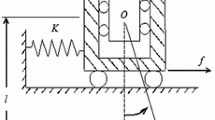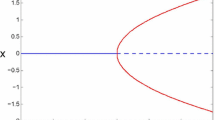Abstract
Analogies are drawn between a physiologically relevant nonlinear delay-differential equation (DDE) model for the pupil light reflex and servo control analytic approaches. This DDE is shown to be consistent with the measured open loop transfer function and hence physiological insight can be obtained into the gain of the reflex and its properties. A Hopf bifurcation analysis of the DDE shows that a limit cycle oscillation in pupil area occurs when the first mode of the characteristic equation becomes unstable. Its period agrees well with experimental measurements. Beyond the point of instability onset, more modes become unstable corresponding to multiple encirclings of (-1, 0) on the Nyquist plot. These modes primarily influence the shape of the oscillation. Techniques from dynamical systems theory, e.g. bifurcation analysis, can augment servo control analytic methods for the study of oscillations produced by nonlinear neural feedback mechanisms.
Similar content being viewed by others
References
Allwright DJ (1977) Harmonic balance and the Hopf bifurcation. Math Proc Camb Phil Soc 82:453–467
Arkin MS, Miller RF (1988) Bipolar origin of synaptic inputs to sustained OFF-ganglion cells in the mudpuppy retina. J Neurophys 60:1122–1142
Bouma H, Baghuis LCJ (1971) Hippus of the pupil: periods of slow oscillations of unknown origin. Vision Res 11:1345–1351
Clynes M (1968) Unidirectional rate sensitivity: a biocybernetic law of reflex and humoral systems as physiologic channels of control and communication. Ann NY Acad Sci 92:949–969
Cornsweet TN (1967) Visual perception. Academic Press, New York
Ellis CJK (1981) The pupillary light reflex in normal subjects. Br J Ophthalmol 65:754–759
Hayes ND (1950) Roots of the transcendental equation associated with a certain difference differential equation. J Lond Math Soc 25:226–232
Krenz W, Stark L (1984) Neuronal population model for the pupil size effect. Math Biosci 68:247–265
Longtin A, Milton JG (1988) Complex oscillations in the pupil light reflex with “mixed” and delayed feedback. Math Biosci 90:183–199
Mackey MC (1979) Periodic auto-immune hemolytic anemia: An induced dynamical disease. Bull Math Biol 41:829–834
Mackey MC, Glass L (1977) Oscillation and chaos in physiological control systems. Science 197:287–289
Mackey MC, Milton JG (1987) Dynamical diseases. Ann NY Acad Sci 504:16–32
Mees AI, Allwright DJ (1979) Using characteristic loci in the Hopf bifurcation. Proc IEE 126:628–632
Milton JG, Longtin A, Kirkham TH, Francis GS (1988) Irregular pupil cycling as a characteristic abnormality in patients with demyelinative optic neuropathy. Am J Ophthalmol 105:402–407
Nardone P, Mandel P, Kapral R (1986) Analysis of a delaydifferential equation in optical bistability. Phys Rev A 33:2465–2471
Nisida I, Okada H, Nakano O (1959) Electrical activity of the pretectal region of the cat to visual stimulus. Yonago Acta Med 4:7–18
Pallu de la Barriere R (1967) Optimal control theory. Dover, New York
Schiller PH (1984) The connections of the retinal ON and OFF pathways to the lateral geniculate nucleus of the monkey. Vision Res 24:923–932
Semmlow J, Chen D (1977) A simulation model of the human pupil light reflex. Math Biol 33:5–24
Stark L (1959) Stability, oscillations and noise in the human pupil servomechanism. Proc IRE 47:1925–1939
Stark L (1962) Environmental clamping of biological systems: pupil servomechanism. J Opt Soc Am 52:925–930
Stark L (1984) The pupil as a paradigm for neurological control systems. IEEE Trans Biomed Eng 31:919–924
Stark L, Cornsweet TN (1958) Testing a servoanalytic hypothesis for pupil oscillations. Science 127:588
Stern HJ (1944) A simple method for the early diagnosis of abnormality of the pupillary reaction. Br J Ophthalmol 28:275–276
Usui S, Stark L (1982) A model for nonlinear stochastic behaviour of the pupil. Biol Cybern 45:13–22
Yoss RE, Moyer NJ, Hollenhurst RW (1970) Hippus and other spontaneous rhythmic pupillary waves. Am J Ophthalmol 70:935–941
Author information
Authors and Affiliations
Rights and permissions
About this article
Cite this article
Longtin, A., Milton, J.G. Insight into the transfer function, gain, and oscillation onset for the pupil light reflex using nonlinear delay-differential equations. Biol. Cybern. 61, 51–58 (1989). https://doi.org/10.1007/BF00204759
Received:
Issue Date:
DOI: https://doi.org/10.1007/BF00204759




